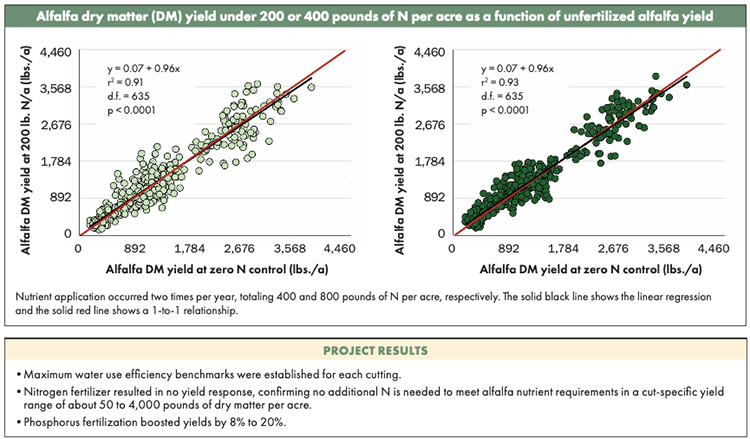
When Kansas State University Extension wheat and forages specialist Romulo Lollato set out to evaluate alfalfa water use efficiency and nitrogen (N) requirements under high-yielding conditions, his motivation was clear. “We wanted to establish a benchmark for how much dry matter alfalfa can produce for every inch of water it uses,” Lollato explained. “We also wanted to determine whether biological N fixation is sufficient to sustain high-yielding alfalfa without supplemental fertilizer.”
Water availability and nutrient balance remain challenges for alfalfa farmers. By better defining alfalfa’s maximum water use efficiency, farmers can compare their on-farm performance with the crop’s potential. This type of benchmarking helps determine whether yield gaps can be closed through improved management.
Additionally, some have questioned whether legumes like alfalfa can fully meet their N needs in high-yielding environments. “Recent studies in soybean suggested nitrogen limitations under high production, and we wanted to verify if that applied to alfalfa as well,” Lollato said.
Research began with a systematic literature review to quantify maximum alfalfa water use efficiency per cut under high-yielding conditions. Lollato only included data from high-quality field experiments where alfalfa dry matter yield and associated evapotranspiration were reported for each individual cut. Next, the team performed field trials to measure N limitation across a wide range of yields, varieties, and fertility programs. The multi-year, high-intensity effort generated more than 5,300 individual data points from both main and subsampled cuts.
Benchmarks established
Analysis showed alfalfa’s water use efficiency varies by cutting: First cut was up to 960 pounds of dry matter per acre per inch of water evapotranspired, while second and third cuts ranged from 740 to 860 pounds, and fourth cut averaged 530 pounds.
“These values give farmers a clear benchmark on water use efficiency,” Lollato said. “Farmers can use these numbers to estimate how far fields actually are from their potential, guiding management adjustments accordingly.”
On the N side, across 13 main cuts and numerous subsamples, yields showed no response to N fertilizer (see graph). “Farmers can rest assured that no additional nitrogen fertilizer is needed to meet alfalfa nutrient requirements, at least for the yield levels we evaluated,” Lollato said. “While this is usually well-known for alfalfa, we wanted to reconfirm since recent evidence for other legumes suggested there might be nitrogen limitations in high-yielding conditions.”
The one fertility factor that did influence yield was phosphorus (P), with broadcast P boosting production by 8% to 20%, depending on year and cut. “From this research, farmers can be confident that investing in nitrogen for alfalfa won’t pay off,” Lollato said. “Instead, focus should be on optimizing water use and phosphorus fertility.”
A full copy of the final report can be found at alfalfa.org.
This article appeared in the November 2025 issue of Hay & Forage Grower on page 14.
Not a subscriber? Click to get the print magazine.
